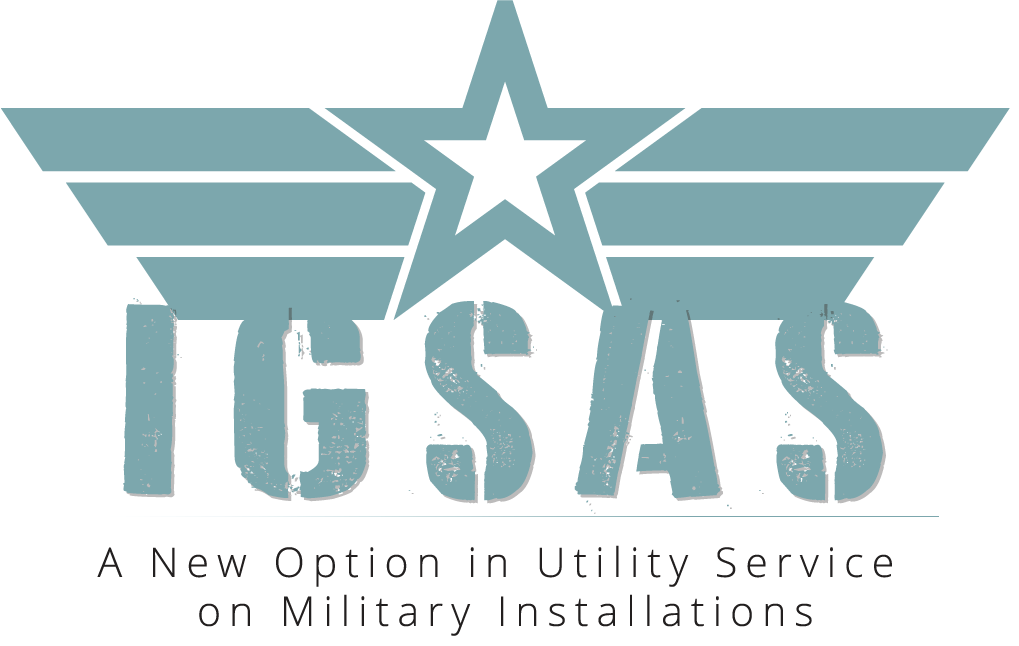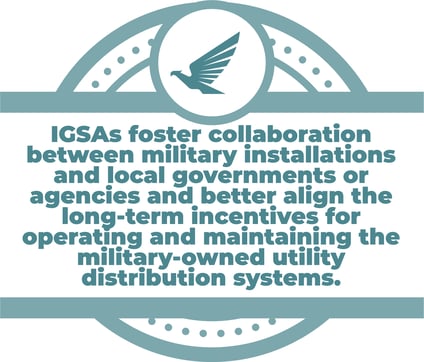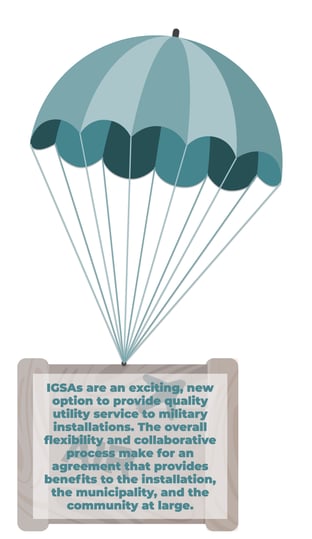- Home
- Services
- Hi-Line Engineering
- About
- Careers
- Contact
- Requests For Proposals
IGSAs - a new option in utility service on military installations
by GDS Associates, Inc | April 19, 2024 | Other Specialized Services , Newsletter - TransActions

HISTORICAL GOVERNMENT UTILITY CONTRACTS
Historically, military installations have relied on Base Operations Support Services (BOSS) contractors for utility operations, often resulting in limited responsibility and long-term maintenance incentives. In response to the need for improved maintenance and funding, the Federal Government initiated Utility Privatization (UP) contracts in the 1990s. UP contracts transfer ownership and operation of utility systems to the private sector for a fixed period, typically 50 years. These contracts aim to enhance the quality, efficiency, and reliability of utility services through private sector expertise and funding.
While there are other military installation utility service contract types, including Utility Energy Service Contracts (UESC) and Energy Savings Performance Contracts (ESPC), recently, there has been a shift towards Utility Inter-Governmental Support Agreements (IGSAs), which foster collaboration between military installations and local governments or agencies and better align the long-term incentives for operating and maintaining the military- owned utility distribution systems.
SERVICE AGREEMENTS CONTRACTS VS TYPICAL OPERATIONS
Privatization and other military service agreements, unless specifically indicated otherwise, do not include the supply of commodities, such as electric power, water, or natural gas, but simply involves ownership, operation, maintenance and replacement of the physical distribution systems over time. The System Owner charges the Government a rate for providing "distribution service." The terms of the service agreement or contract include things like operations, maintenance, and capital projects. Due to supply of commodities not being included in the scope, cost recovery for these contracts and agreements works differently from traditional utility rates. The military installation receives service from the commodity provider up until a Point of Demarcation (POD). Starting at that POD, the distribution system operation and maintenance responsibilities now belong to the System Owner, as well as plant replacement as funding is available.
This presents a challenge to traditional utilities when determining the appropriate pricing structure for a military distribution system privatization agreement. Most cooperatives and municipalities charge their retail customers on a consumption basis; they aren’t contractors who typically price their work based on labor, materials, etc. Moreover, these contracts / agreements are based on a fixed price with predetermined price adjustment methods and timeframes. Utilities operate in a very fluid business cost environment. While costs can be forecast to a degree, it’s atypical to sit down and assign cost based on factors more commonly used by contractors, such as labor, materials, and transportation, for the operations and maintenance of a distribution system.
HISTORY OF IGSAS
In recent years, IGSAs have emerged as a popular option for military installations to procure services from external utility companies. These agreements, established between the US Department of Defense (DoD) and various federal, state, local, or tribal governmental entities, facilitate resource sharing across different governmental entities. Initially developed for installation support services such as dog-catching, recycling collection, or elevator maintenance, IGSAs enable military installations to access services already offered by local governments to their citizens or retail rate payers.
Unlike traditional procurement processes governed by the Federal Acquisition Regulation (FAR) and Defense Federal Acquisition Regulation Supplement (DFARS), IGSAs allow the DoD to engage in sole-sourcing agreements, fostering a collaborative approach with installations rather than competitive bidding against other contractors. This flexibility enhances cooperation between military installations and local governments, streamlining the process of accessing essential services while promoting efficient resource utilization.
MILITARY INSTALLATION UTILITY IGSAS
In 2021, the DoD began exploring the idea of applying the IGSA concept to entire installation utility systems. IGSAs are very comparable to UP contracts. The major difference between an IGSA and a traditional UP contract is ownership of the system. Under the UP framework, the contract includes ownership of the system for the duration of the 50-year contract. Under an IGSA, the military retains ownership and hires the municipality to operate, maintain, and repair the system.
The military's reliance on IGSAs for utility system maintenance stems from its strategic objective to foster local relationships, engagement, and utilize local resources efficiently. This trend reflects a broader shift towards community integration and collaboration. For instance, Redstone Arsenal in Alabama has established IGSA agreements with the local municipality to maintain utility systems, leveraging the expertise and resources available within the community. Similarly, Fort Carson Air Force Base in Colorado has forged partnerships with local entities to ensure the seamless operation of utility services critical to both military personnel and nearby residents. This symbiotic relationship is further evidenced by the fact that many customers of local municipal utilities are also employed at military installations, underscoring the interconnectedness between the military and the surrounding community. By aligning long-term incentives and initiatives, both military installations and municipalities strive to ensure the sustained functionality and resilience of utility systems while enhancing overall community welfare and cohesion.
WHO/WHERE
Unlike the previously utilized contract types, IGSAs are limited in what utilities are eligible. The IGSA program is specifically geared towards local municipalities, not cooperatives and for-profit utility companies. The goal of an IGSA is to utilize the services provided by the local government.
WHY
IGSAs have both advantages and disadvantages when compared to the historically more common UP contracts.
ADVANTAGES
- Maximum term of 10-years, making it a shorter-term option when compared to the 50-year terms required in UP contracts.
- Due to the military installations ability to sole-source IGSAs, they are more transparent about what they really need. This allows both parties to collaborate and determine the best way to operate and maintain the system to meet the requirements of both the utility and the installation.
- IGSAs are more flexible, due to being “agreements” rather than “contracts”. As conditions change, either party to the agreement can sit down and make adjustments as the need arises, rather than the more formal and rigid “Request for Equitable Adjustment” process used in UP contracts.
- IGSAs are exempt from traditional contracting statutes and regulations, such as FAR and DFAR clauses, and does not have to comply with a typical federal subcontracting plan.
DISADVANTAGES
- These agreements have a maximum term of 10 years. While they can be renewed, it’s not a guarantee.
- Due to it being a Public-Public partnership program, only municipalities are eligible to participate. UP contracts are also open to cooperatives, IOUs, and contractors.
- In UP contracts, the contract owners have significantly more autonomy compared to municipalities with IGSAs because of the ownership structure inherent in UP contracts. In UP contracts, the private entity or contractor typically owns the utility systems outright. This ownership gives UP contract owners full control over the management, maintenance, and upgrades of the utility infrastructure. They have the authority to make decisions regarding system operations, investment in upgrades or expansions, and setting rates for the services provided.
HOW
If a municipal utility company is interested in initiating an IGSA with a local military installation, there are some proactive measures they can take.
1. Do their research on the installation. Understand the energy and utility needs, as well as the style of contract the installation currently utilizes for their utility systems. BOSS contracts are shorter term than UP contracts. If the system has already been privatized, it’s less likely that the installation will be interested in or have the option to engage in an IGSA.
2. Identify points of contact. Not only should the municipality identify the appropriate points of contact in the military, but also look internally. Does the installation already reach out to the municipality for help? Who do they work with? Identify any preexisting relationships.
3. Engage in initial discussions and gauge interest. Because IGSAs can be sole sourced, the DoD doesn’t have to formally start the process. Municipalities can initiate discussions with the military installation’s leadership or relevant decision-makers to express their interest in exploring the possibility of an IGSA.
All-in-all, IGSAs are an exciting, new option to provide quality utility service to military installations. The overall flexibility and collaborative process make for an agreement that provides benefits to the installation, the municipality, and the community at large.
For more information or to comment on this article, please contact: Katie Dugan Barrett, Project Engineer
Katie Dugan Barrett, Project Engineer
GDS Associates, Inc. - Marietta, GA
770.799.2477 or
katie.barrett@gdsassociates.com
GET OUR NEWSLETTER
RECENT POSTS
- Why MOD-026-2 Matters: Raising the Bar for Generator and IBR Modeling Reliability
- Exploring the 2026-2028 Reliability Standards Development Plan
- Blackstart Resource Availability During Extreme Cold Weather Conditions
- DOE Pushes FERC to Accelerate Large Load Grid Access
- Building a Cyber-Aware Workforce in the Utility Sector
Archives
- December 2015 (8)
- June 2025 (7)
- January 2016 (6)
- July 2016 (6)
- March 2021 (6)
- May 2022 (6)
- August 2020 (5)
- March 2015 (4)
- January 2019 (4)
- June 2019 (4)
- August 2019 (4)
- February 2020 (4)
- May 2020 (4)
- June 2020 (4)
- December 2020 (4)
- July 2021 (4)
- October 2021 (4)
- April 2024 (4)
- December 2024 (4)
- May 2025 (4)
- April 2015 (3)
- August 2016 (3)
- February 2017 (3)
- July 2017 (3)
- February 2018 (3)
- February 2019 (3)
- November 2019 (3)
- March 2020 (3)
- April 2020 (3)
- September 2021 (3)
- December 2021 (3)
- August 2022 (3)
- December 2022 (3)
- April 2023 (3)
- July 2023 (3)
- December 2023 (3)
- September 2024 (3)
- October 2025 (3)
- December 2025 (3)
- May 2014 (2)
- February 2016 (2)
- March 2016 (2)
- September 2016 (2)
- November 2016 (2)
- January 2017 (2)
- July 2018 (2)
- November 2018 (2)
- March 2019 (2)
- May 2019 (2)
- July 2020 (2)
- September 2020 (2)
- April 2021 (2)
- August 2021 (2)
- October 2024 (2)
- September 2025 (2)
- February 2014 (1)
- April 2014 (1)
- July 2014 (1)
- August 2014 (1)
- November 2014 (1)
- February 2015 (1)
- May 2015 (1)
- June 2015 (1)
- November 2015 (1)
- October 2016 (1)
- December 2016 (1)
- October 2018 (1)
- December 2018 (1)
- April 2019 (1)
- July 2019 (1)
- September 2019 (1)
- October 2020 (1)
- November 2020 (1)
- February 2021 (1)
- April 2022 (1)
- July 2022 (1)
- October 2022 (1)
- August 2023 (1)
- October 2023 (1)
- July 2025 (1)
- November 2025 (1)
Categories
- Newsletter - TransActions (85)
- News (78)
- Employee Spotlight (35)
- Energy Use & Efficiency (28)
- Energy, Reliability, and Security (17)
- Other Specialized Services (11)
- Environment & Safety (10)
- Power Supply (8)
- Transmission (8)
- NERC (7)
- Utility Rates (7)
- Cyber Security (5)
- Energy Supply (4)
- Hi-Line: Utility Distribution Services (4)
- Battery Energy Storage (3)
- Uncategorized (2)
- Agriculture (1)
- Hi-Line: Seminars & Testing (1)